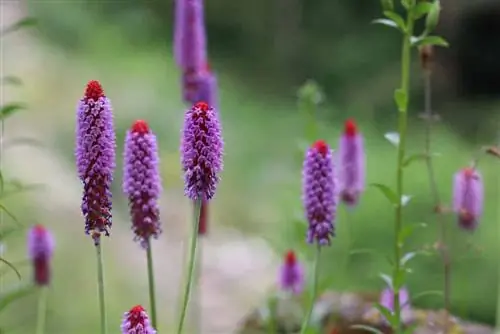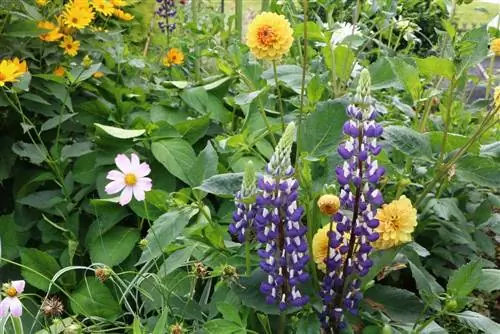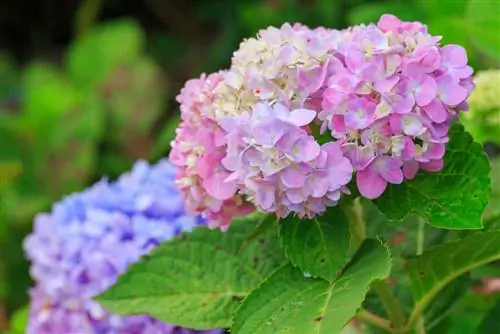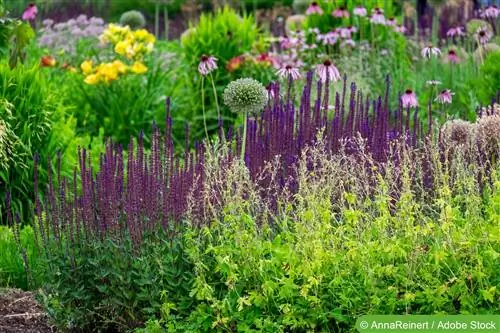- Author admin [email protected].
- Public 2023-12-17 03:39.
- Last modified 2025-01-24 12:45.
The name of the cowslip was coined by the striking resemblance of the plant's inflorescence to a bunch of keys. However, the cowslip is also popularly known as the meadow primrose, the spring cowslip, the meadow cowslip, the medicinal cowslip and also the key to heaven.
In nature it is a perennial and relatively herbaceous plant that grows to heights of between eight and 30 centimeters and is usually found in smaller and larger groups.
Sowing
If you want the cowslip to thrive in your own garden and it is already there, then it is sufficient to leave the flowering stems that have already bloomed for a long time so that they can simply sow themselves again in the current location. But the plant can also be sown in a bowl without any problems. The cowslip itself is considered a cold germinator. This means that the seeds are initially kept moist and warm at a temperature of around 15 to 20 °C for around two to four weeks. They can then be exposed to a temperature of -4°C to +4°C for four to six weeks. The primrose itself can be easily propagated by self-sowing or indoors in the plant bowl.
Location

The cowslip thrives best in dry locations, as the cowslip is botanically related to the primrose with similar requirements. The cowslip, which has already been grown in the nursery, can easily be planted in your own garden. In nature, the protected plant occurs primarily in areas with low and grassy lawns and in sunny and rather dry locations. These location preferences should therefore also be taken into account in your own garden. That's why the cowslip is best kept in a sunny spot with dry soil. The cowslip loves normal to slightly loamy soil and a pH value in the soil that is neutral to slightly alkaline.
Tip:
The soil value can be easily measured in terms of its pH value using small test sticks, which are available in pet stores for aquarists.
Plants
The cowslip particularly likes sunny and partially shaded locations, which should be taken into account when planting. For this purpose, the first planting of the garden area with primroses should be planted on loose, calcareous soil. If the soil is rather heavy and compacted, mixing it with coarse sand can ensure better permeability of the soil. In addition, it is recommended to incorporate garden lime before planting primroses, especially in heavy and compacted soils.
It is best to plant the cowslip in autumn. A distance of around 10 to 15 cm between the individual plants is recommended. In order to have a beautiful, colorful and spring-flowering bed in spring, you can combine it with other early bloomers such as tulips or daffodils as well as violets and hyacinths and daisies. The cowslips also look very beautiful under bushes and trees because they create bright accents in the garden. However, the requirements of the cowslip in terms of lighting conditions should be taken into account here.
- sunny and partially shaded locations
- loose and calcareous soil
Repotting
The cowslip is a relative of the primrose and can therefore also be kept in a pot. Even in the pot, the plant needs nutrient-rich, humus-rich soil that retains moisture well. A semi-shady location when kept in a pot is recommended so that the plant's substrate does not dry out too quickly, especially in summer temperatures. In the pot, the plant definitely needs protection from warm summer sun so that it does not dry out. After flowering, the plants can easily be released from the pot into the open ground. The plants are planted ten to fifteen centimeters apart.
Pouring
The cowslip itself is very undemanding. However, she resents the lack of water very much. Especially on hot summer days, the cowslip needs generous and, above all, regular watering. These should best not be administered in direct sunlight, but in the morning and evening hours. If there are long dry periods, regular watering is also urgently required. It is important that the root ball of the cowslip never dries out, as this can mean its end.
Tip:
It's better to water rarely, but very thoroughly and for a long time. Only if sufficient water is supplied can the moisture penetrate deep into the soil and reach the root ball. If, on the other hand, you only water briefly several times a day, most of the liquid evaporates on the surface of the soil without penetrating into the roots.
- high fluid requirement
- water very intensively once or twice a day in hot summer phases
Fertilize
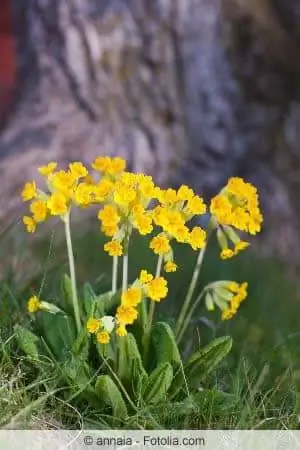
If the soil has sufficient humus, then fertilizing the cowslip is not absolutely necessary. However, so-called boost fertilization can prove to be very useful, especially in spring. This gives the plant many important nutrients for the coming season and the flowering period and also the appropriate strength after the cold winter period. There is no need for special fertilizer. A conventional liquid fertilizer for flowering plants, which is available commercially, is completely sufficient for booster fertilization.
Cutting
Pruning the cowslip is not absolutely necessary. The plant, which lives in nature, is not cut and blooms every year. However, if you want to stimulate flowering and have a blooming cowslip in your garden for as long as possible, you should cut off the spent flowers regularly, as this is a great way to stimulate the growth of additional flowers within one season.
Wintering
The cowslip itself is hardy. It is still advisable to temporarily move plants that are in pots to a cool but frost-free place during the frost periods. If the potted plant is to be transferred to the bed after overwintering, it is recommended to change it after flowering.
- hardy in the bed
- As a potted plant, a cool and frost-free place is required
Propagate
The easiest way to propagate cowslips in your own garden is to collect the seeds from existing plants. This has the advantage that the seeds do not spread over the entire property and sow themselves, but can be used again in a targeted manner. It is recommended to slit a plastic bowl halfway down and place it under the flower stem to protect it from the wind. Sowing can then be carried out easily in small plant pots, whereby the plants can ultimately be placed individually in planters as well as in outdoor beds.
Pests
The plant is relatively resistant to pests; typical enemies of the cowslip are not known. The only problem can be dryness, to which it reacts sensitively and is then no longer resistant to pests. In order to achieve protection in addition to intensive watering, it is recommended to provide the plant with compost in spring or to mulch the soil around the root ball.
no known pests as enemies
Frequently asked questions
Can I collect the plants in nature for seed procurement and propagation?
Procuring seeds from nature by collecting wild plants is prohibited because the cowslip is a protected species. Seeds should be purchased from the garden center.
Do cowslips really have healing properties?
The cowslip has both an antispasmodic and expectorant effect and is therefore very effective as a cough tea. To do this, about three grams of the flowers are poured with hot water, left to steep for a maximum of 10 minutes and then drunk.
What you should know about cowslips in brief
The real cowslip, Primula Veris, is a well-known herald of spring that is native throughout Europe, even deep into the Middle East. The cowslip is also known by many other names. So now and then it is also called the sky key or the meadow cowslip or the spring cowslip.
Location & Care of the Cowslip
- Primroses prefer to grow at the edges of forests, in meadows and in open forests.
- But also on the edges of ponds and in small meadows, forest clearings.
- It is important that it reaches the warming rays of the sun.
- Primroses bloom from around the beginning of April and sometimes well into June.
- They love loose and calcareous soil.
As the cowslip grows, it forms a small rosette with elongated leaves. However, the leaves do not lie close to the earth, but grow in small clumps that are cheerfully mixed up. The beautiful yolk-yellow flowers, which are sometimes decorated with small orange-yellow spots and sometimes even tiny red dots in the middle, have a scent that ranges from weak to heavenly strong, depending on the variety.
Healing effects
- The root of the cowslip contains a medicinal drug that is used to cough up mucus in bronchitis.
- In addition, the cowslip flowers contain active ingredients that have a calming and antispasmodic effect on coughs.
- An infusion is made from the dried flowers, which you then drink in sips throughout the day, sweetened with a little honey.
This infusion can also be used to treat sleep disorders, but then it needs to be taken for a longer period of time. However, it is advisable to do this under the supervision of a doctor. In the mountainous regions of Europe, the cowslip flower is also used to dye Easter eggs because it contains a lot of carotene. Since the cowslip is protected, you should use a different color to dye the Easter eggs. The same applies, even if it is difficult to pick a spring bouquet while taking a walk.
Buy primroses
- You can purchase cowslips in well-stocked specialist shops, but also by mail order.
- Sometimes you can find small plants on the internet.
Since the cowslip is a perennial plant, purchasing this spring flower is worthwhile not only as a medicinal plant, but also as a feast for the eyes and a splash of color for your own garden.



